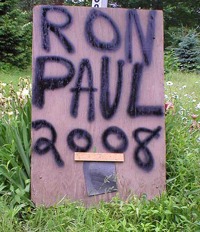Ron Paul’s Revolution
Posted At: April 9, 2008 12:09 PM
by Caitlin Graham
Campaign tactics are meant to grab attention, and as unobtrusive front yard signs have evolved into nasty television commercials, the election in 2008 is no different … almost no different. Ron Paul, a Republican congressman from Texas, has put campaigning in the hands of his voters with unexpected and interesting results.
While driving across a bridge in Tuscaloosa, Ala., I had my first Paul encounter. Hung along the pedestrians walkway was a king-size white sheet instructing me in large black letters to GOOGLE RON PAUL. So I did. My interest was piqued by the lengths Paul’s supporters had gone in a town dead set on presidential hopeful Mike Huckabee. What campaign platform, what ideas, what person could illicit such dramatic support? Far from simply placing a bumper sticker on their back windows, these campaigners chose a method that was impossible to miss, as well as a lot more dangerous.
And that is just the beginning. Central to Paul’s campaign is the theme “revolution” with the letters “evol” flipped within the word to spell “love.” Whether or not the theme has inspired his supporters, their campaign efforts are nothing short of revolutionary.
While mainstream candidates are still relying on commercials, billboards and radio spots, Paul is high above those tired methods, literally. Paul has a blimp. And not just any blimp, but one featuring his message of “revolution,” along with “Who is Ron Paul” and “Google Ron Paul.” And instead of simply floating across America this blimp dropped tea into Boston Harbor coinciding with the Boston Tea Party of 1773, all while helping Paul set a record of $6.04 million for single-day political donations. Just as astounding as the blimp and the fundraising record is that this entire effort was spearheaded not by Paul’s official campaign, but through grassroots efforts.
While the majority of presidential campaigns would find one blimp to be enough, Paul’s supporters have turned out two smaller blimps, one canvassing the San Diego area and the other Salt Lake City.
These voter-initiated tactics are inspired by a respect and support for Paul who represents a different kind of politician, says Scott Morris, who traveled from Alabama to Iowa and South Carolina to campaign. “I went to Iowa as a student volunteer … people were there from Los Angeles to Florida to Oregon to Pennsylvania,” says Morris. “We went canvassing for ten days … it was not a cakewalk; it was snowy there was ice and a wind chill of -8°.”
According to Morris, the grassroots revolution came from supporters of a different kind of Presidential campaign, one that was more concerned with people than political parties. “Paul has by far the most homemade signs out there,” said Morris. “People are doing weird stuff to get his name out there … homemade signs are real support. That is passion.”
 The overwhelmingly grassroots angle of Paul’s campaign puts public relations into the hands of the voters, a move that sets him apart from other campaigns. This works to strengthen voter loyalty, illustrated by Paul’s impressive fundraising. The $6.04 million was donated not from large corporations but by just over 58,000 individuals at an average of $102 per person. As supporters take a more active role in Paul’s public relations, his image becomes more accessible and approachable.
The overwhelmingly grassroots angle of Paul’s campaign puts public relations into the hands of the voters, a move that sets him apart from other campaigns. This works to strengthen voter loyalty, illustrated by Paul’s impressive fundraising. The $6.04 million was donated not from large corporations but by just over 58,000 individuals at an average of $102 per person. As supporters take a more active role in Paul’s public relations, his image becomes more accessible and approachable.
And while this means giving campaigners the ability to control the public relations message the risk has been worthwhile for Paul as supporters have produced overwhelming results. However, the risk has also produced unsavory results as neo-Nazi groups openly supported Paul for president, though Paul’s Web site (https://www.ronpaul2008.com) denounces racism.
Paul’s campaign, while showing strong followings on the Web sites MySpace and the Facebook, and in Internet search engines, failed to translate into any major wins in the Republican primaries, but his innovative tactics will hopefully become a staple in future political campaigns and turn the now cut-throat methods into creative expressions of support.
Sources:
(2008). Ron Paul 2008—Hope for America. Retrieved March 1, 2008, from Ron Paul 2008 Web site: https://www.ronpaul2008.com/
Yao, N. Tea Party ’07 Mass Donation Day. Retrieved March 3, 2008, from Ron Paul for President Web site: https://teaparty07.com/
Photo: Katherine Grossman
Is PR in the hands of voters a good idea? What lengths would you go to in campaigning for a political candidate?


